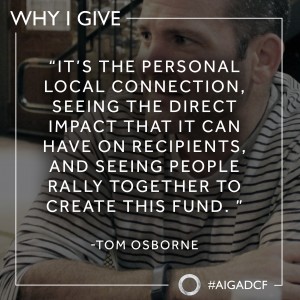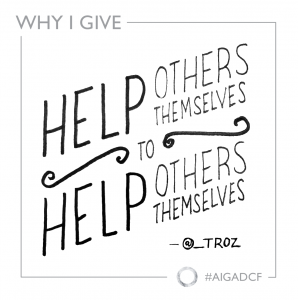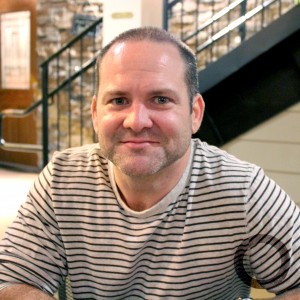“Why I Give” is a series of interviews with the AIGA DC Design Continuum Fund donors about their reasons for supporting and their perspectives on the role secondary education played in their careers.
The AIGA DC Design Continuum Fund was established in 2007 to support aspiring designers and creatives in fulfilling their higher-level education goals. After aiding eleven recipients, we wanted to know more about the donors who give to the Fund year in and year out, and helped work towards establishing an endowment. Their donations and the financial support of our community are helping another generation of designers through college!

Tom Osborne is a Design Director at Viget and a Circle Friend donor of the Fund. We sat down with him at a small restaurant near Viget in Arlington to discuss the importance of scholarships in a designer’s creative career.
How did you find out about The AIGA DC Design Continuum Fund (DCF)?
I first heard about it when Jill Spaeth contacted me at Viget asking if we could help build the DCF website. Of course, the answer was yes. And that’s where I learned more about the scholarship, what the mission was, and what they aimed to do. Jill and [the rest of the DCF committee] talked about their goals. We got a team together and started to design the project.
At the AIGA Gala, I made a contribution and just continued to do that. Just knowing that scholarships were given out and the recipients were involved with AIGA encouraged me.
To see [the 2012 and 2013 Scholarship Winner] Laura Guzman Aguilar get involved, attend the AIGA DC events, and express her gratitude and purpose really made a difference. That is how this scholarship is different from other ones I’ve seen. It’s the personal local connection, seeing the direct impact that it can have on recipients, and seeing people rally together to create this fund.
One thing we’ve been hearing from a lot of people we are interviewing is how different this scholarship is compared to others out there, including the community aspect. It sounds like Laura made an impact in the DCF community with her contagious enthusiasm.
Definitely. Laura’s charged [and] going places. I haven’t met the other recipients. So in my mind she represents the rest of them. I hope all the recipients follow a similar model of being involved in the DCF and AIGA DC community.
Even to see Laura show up at portfolio reviews. From viewing her portfolio when she first received the scholarship to a few years later, she’s really applied herself and grew thanks to her dedication and DCF.

Do you have familiarity with other scholarships that compare to DCF?
Not that I have run into. There aren’t that many AIGA chapters that have done something like this. There are a few that are looking to DC as a model, which is really cool. We can be an inspiration to others and show how it can be done.
DC is blazing the path! Have scholarships been part of your career and how you got to where you are?
Yes, I had small scholarships and a little help along the way. One scholarship came out of a portfolio competition for seniors in my high school. They selected a handful of recipients to win the scholarship. It wasn’t a lot but it was a little help for school and supplies. It was a mental boost to be like “Hey, this is something you should pursue”. In high school, I didn’t have an idea of what I wanted to do. That financial boost was helpful in encouraging me to go down a design path.
I had some help from my church too, which wasn’t specific to design. But it was one more thing to [show] that people care. There will always be help along the way if you seek it out. That’s important. A lot of people feel that they have to figure it out on their own, but you have to take the initiative to get scholarships. If you don’t apply, you won’t receive it.
Lots of confidence comes from receiving a scholarship especially as a young designer.
One of the great quotes I heard was “College is about what you don’t want to do, not what you want to do.” So even being in a process of elimination and having financial help to reinforce that you’re good at this, is such a big help.
If you were meeting with someone who wasn’t sure to get involved with the Design Continuum Fund, what would be your elevator pitch?
Anytime when you ask someone to contribute money, it’s difficult. You don’t always have to donate money, but also contribute time. My elevator pitch would be that there is this local Washington Design Continuum Fund that gives out scholarships year after year after year. You can start out small giving time or money to be part of something big. I can’t wait to look back ten years from now to see where it goes.

There is this movement of people pursuing a design career but not going to college. This scholarship is really interesting because it’s encouraging people to pursue a higher education. I’m curious what your thoughts on higher education are and the benefits.
I don’t think that school is necessary anymore. If you know what you want to do, everything you need to know and all the tools are out there. You just have to find it.
But there are huge benefits to going through a program, whether that’s online or in person. The program I went through had thirty other design students. In a program, you can learn how to defend your ideas, take criticism and not let it weigh you down. Taking some punches and rising to the occasion is important.
One thing I run into with designers at the beginning of their career is that they can pitch work but the response to feedback is an issue. If you’re skipping pursuing a higher education, you’ll have to learn the hard way when it comes to responding to feedback. School is a nice and easy buffer to practice this with other students.
The other thing I like about school was that you’re taught about design thinking and not just software. You can come up with many more ideas instead of just one and can filter those down.
Since this grant is given to young designers, what advice would you give to those just getting into college or continuing with their education?
Be resilient. People are going to wear you down, the work will wear you down, and life will try to pull you away from design. On the outside looking in, design looks sexy. I tell my friends what I do and they say “Really, you get paid to do that!?”. But the truth is, it is a lot of work. It can be slow moving, other times it’s breakneck and you’re working late nights. You’re sacrificing time away from your friends or family to do work for other people. Learning to be resilient is a huge component that not everyone gets right off the bat.
The other thing is that you’re in the business to help others help themselves. There’s a little bit of selfishness we’re taught in design school. You are taught to design for yourself. That’s the fun part when you have full control over what you’re doing. But when you’re working in client services, you’re working for other people. Young designers should take all this into consideration as they go through their design education.
Chelsae Blackman and Liz Rose Chmela are AIGA DC Design Continuum Fund committee members.